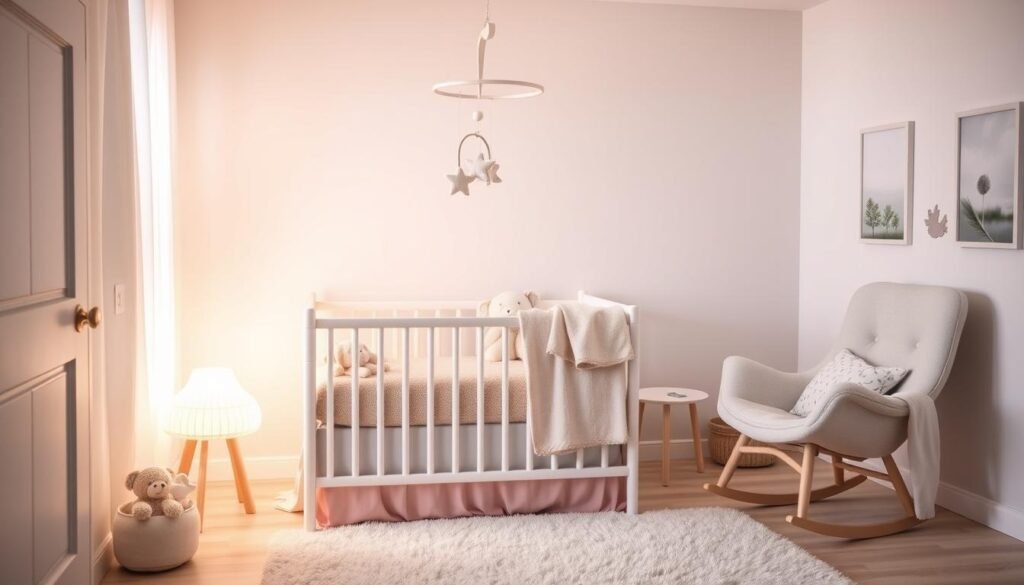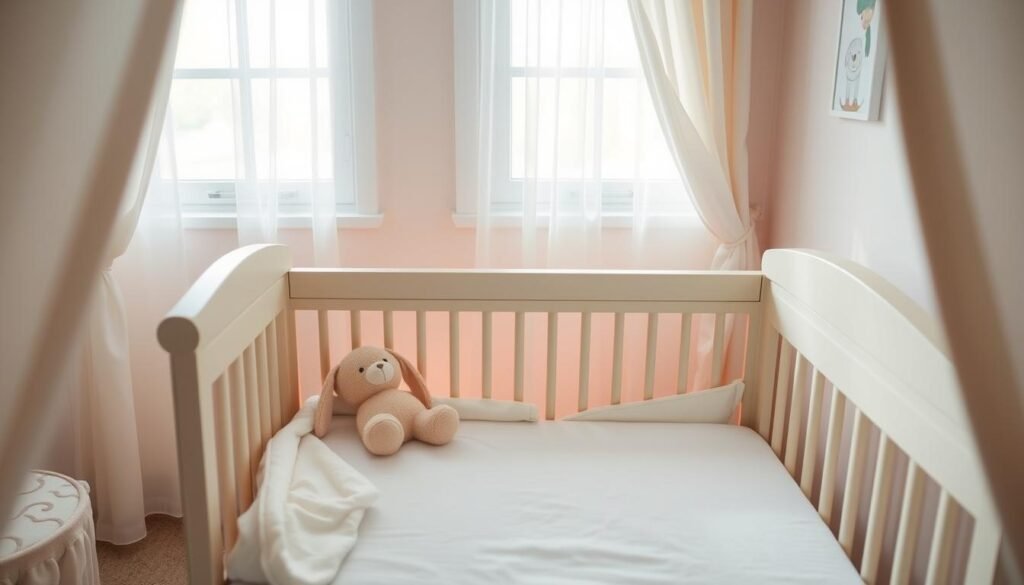Being a parent of a seven-month-old is a big responsibility. A well-rested baby is key to a happy home. At this age, babies need about 14 hours of sleep in a day. This includes 11-12 hours at night and 2.5-3 hours during the day.
They usually take 2-3 naps a day. Their wake windows can be between 2.25-3.5 hours. This depends on the time of day and how many naps they have.
Watching your baby’s sleep patterns is very important. It helps them get the rest they need. Knowing how much sleep a seven-month-old needs helps you create a good sleep routine. This routine supports their growth and development.
Understanding Sleep Patterns at Seven Months
When your baby hits seven months, you might see changes in their sleep. They need about 14 hours of sleep each day. This includes 11-12 hours at night and 2.5-3 hours during the day. Sleep hours for a 7-month-old can range from 12 to 16 hours.
Average Sleep Duration and Needs
A 7-month-old baby sleeps around 14 hours a day. This includes two or three naps and nine to 11 hours at night. Their sleep helps their brain and body grow fast. Sleep regressions can happen at 4, 6, 8, and 12 months, linked to big developmental steps.
Wake Windows and Sleep Cycles
The wake windows for a 7-month-old baby start at 2-3 hours and grow to 2.5-3.5 hours by 8 months. These are the times when your baby is awake and ready to play. During these times, they go through sleep cycles that last about 45 minutes.
Signs of Sleep Readiness
When your 7-month-old is getting sleepy, you might see them rubbing their eyes or yawning. They might also seem less active. At this age, they might start having only two naps, with each nap lasting at least an hour.
“Sleep is the golden chain that ties health and our bodies together.” – Thomas Dekker
It’s key to understand your 7-month-old’s sleep needs for their health and growth. By watching for sleep signs and adjusting their schedule, you help them get the rest they need to grow strong.
Sample 7 Month Old Sleep Schedule
It’s important to have a regular sleep routine for a 7-month-old baby. A typical day might look like this:
- Wake up: 7:00 AM
- First Nap: 9:15 AM – 11:15 AM
- Second Nap: 12:45 PM – 2:15 PM
- Optional Third Nap: 4:15 PM – 5:00 PM
- Bedtime: 7:30 PM
This schedule helps your baby get 11-12 hours of sleep at night and 2.5-3 hours during the day. Together, they get the 14 hours of sleep a 7-month-old needs.
Wake windows for a 7-month-old are usually 2.25 to 3.5 hours. But, your baby’s sleep needs can change. So, you might need to adjust the nap times and lengths as they grow.
| Activity | Time |
|---|---|
| Wake Up | 7:00 AM |
| First Nap | 9:15 AM – 11:15 AM |
| Second Nap | 12:45 PM – 2:15 PM |
| Optional Third Nap | 4:15 PM – 5:00 PM |
| Bedtime | 7:30 PM |
Every baby is different, and this schedule is just a guide. Watch for your baby’s sleep signs and tweak the routine if needed. This ensures your 7-month-old gets the right amount of sleep.

Transitioning From Three Naps to Two
When your baby hits 7 months, they might be ready to drop that third nap. This change is exciting but can be tricky. We’ll look at signs your baby is ready, how to adjust, and tips for their wake windows.
Signs Your Baby is Ready to Drop a Nap
Most babies drop to two naps between 6.5-8 months. Look for these signs:
- They resist the third nap or nap too short.
- They need more than 10 hours of sleep at night.
- They find it hard to fall asleep for naps or bedtime.
Managing the Transition Period
Adjusting to two naps takes 2-4 weeks. Your baby might switch between 2 and 3 naps as they adjust. Be patient and watch for their cues.
Adjusting Wake Windows
With the third nap gone, wake windows get longer. For a 2-nap schedule, they are:
- 2.5-3 hours before the first nap.
- 3-3.5 hours before the second nap.
- 3-3.5 hours before bedtime.
Too long before bedtime can lead to night wakings. A bedtime of 6:00-6:30 pm might help if the second nap ends early.
The baby nap transition is tough, but patience and flexibility help. Watch your baby’s sleep cues and adjust their schedule. Soon, you’ll have a smooth two-nap routine for your family.
Creating the Perfect Sleep Environment
As a parent of a 7-month-old, setting up a sleep-friendly nursery is key. It should be dark, cool, and quiet. This helps your baby sleep well.
Start by getting blackout curtains or blinds to keep out light. Keep the room at 68-72°F for your baby’s comfort. A white noise machine can also help by blocking out loud noises.
Make sure the crib is safe and clear of anything that could be a hazard. Use a sleep sack for warmth and safety. A consistent sleep space helps your baby know it’s time to sleep.

The perfect sleep space for a 7-month-old is safe, soothing, and consistent. It makes your baby feel secure and comfortable. By focusing on these details, you help your baby sleep well and grow strong.
| Sleep Environment Element | Recommended Setting |
|---|---|
| Lighting | Blackout curtains or blinds |
| Temperature | 68-72°F |
| Noise | White noise machine |
| Crib Furnishings | Clear of loose items, use sleep sack |
Essential Sleep Safety Guidelines
Keeping your 7-month-old safe while they sleep is very important. By following key sleep safety tips, you can lower the risk of SIDS and other sleep dangers. Let’s look at the main ways to keep your baby safe while they sleep.
Safe Sleep Practices
The American Academy of Pediatrics (AAP) says to put your baby on their back to sleep. This can greatly reduce SIDS risk. Make sure the crib is clear of loose bedding, toys, and bumpers, as they can be dangerous. Also, using a pacifier during sleep can help prevent SIDS.
Room Temperature and Clothing
It’s important to keep the room temperature between 68-72°F (20-22°C) for your baby’s comfort and safety. Dress your baby in one layer more than you wear to keep them comfortable all night.
Crib Safety Standards
Make sure the crib is safe for your baby’s sleep area. The crib slats should be no more than 2 3/8 inches (60 mm) apart to avoid entrapment. Always check the crib for loose parts or damage that could be harmful.
| Safety Guideline | Recommendation |
|---|---|
| Sleep Position | Back sleeping |
| Crib Bedding | No loose items |
| Pacifier Use | Recommended |
| Room Temperature | 68-72°F (20-22°C) |
| Crib Slat Spacing | No more than 2 3/8 inches (60 mm) |
By following these essential sleep safety tips, you can create a safe sleep space for your 7-month-old. This helps prevent infant sleep safety, SIDS prevention, and crib safety issues.

Common Sleep Challenges at Seven Months
The seven-month mark can bring sleep challenges for babies. As they grow and hit new milestones, their sleep can get disrupted. Let’s look at some common sleep issues at this age.
Sleep Regression
A sleep regression often hits between 7-10 months. Babies grow a lot and this can mess with their sleep. A consistent bedtime routine and gentle sleep training can help.
Teething and Separation Anxiety
Teething pain and separation anxiety can also disturb sleep. Soothing teething remedies and calming bedtime activities can help.
Increased Mobility
Babies becoming more mobile can make sleep hard. A safe, comfy sleep space and fun daytime activities can help.
Being consistent is crucial at seven months. A predictable routine, sleep strategies, and professional help can help babies sleep better. This way, they can overcome sleep challenges and develop good sleep habits.
Establishing a Bedtime Routine
Creating a bedtime routine is key for healthy infant sleep habits and a consistent sleep schedule for your 7-month-old. This routine signals to your baby it’s time to sleep. It makes them ready for a good night’s rest.
Components of a Successful Routine
A good bedtime routine might include a calming bath, a gentle massage, story time, and a final feeding. Keeping it consistent and soothing helps your baby know it’s time to sleep. Start the routine 30-45 minutes before bedtime to help them relax and get sleepy.
Timing Your Routine
Most 7-month-old babies sleep best between 7:00-8:00 PM. But, if they miss a nap or have a late-day event, bedtime might be earlier or later. Watch your baby’s wake windows, usually 2.5-3.5 hours, to avoid them being too tired at bedtime.
A consistent bedtime routine not only helps with better baby bedtime routine. It also supports healthy sleep habits for years to come.
“Establishing a bedtime routine is one of the most important things you can do to help your baby sleep better. It creates a sense of predictability and security that can make all the difference in how well they settle down for the night.”
Daytime Activities and Their Impact on Sleep
As parents, we often wonder how our baby’s daytime routine and activities can impact their sleep patterns. During the crucial 7-month stage, finding the right balance between stimulation and rest is key. This ensures your little one gets the quality sleep they need. Let’s explore how daytime activities can influence your baby’s sleep and development.
Engaging in age-appropriate activities during the day is essential for your 7-month-old’s growth and well-being. Tummy time, reaching for toys, and exploring different textures can all contribute to their physical and cognitive development. These activities not only support their milestones but can also help tire them out. This leads to more restful naps and nighttime sleep.
It’s important to remember that while active play is important, it’s equally crucial to provide your baby with periods of quiet time throughout the day. Overstimulation close to nap or bedtime can disrupt their sleep cycles. This makes it harder for them to fall and stay asleep. Aim for a balance of active and calm activities to help your baby transition smoothly between periods of play and rest.
Exposure to natural light during the day can also have a positive impact on your baby’s sleep. Sunlight helps reinforce their circadian rhythms, which regulate their sleep-wake cycle. By ensuring your baby spends time in well-lit areas during the day, you can support their body’s natural sleep-wake patterns. This promotes better sleep overall.
Remember, every baby is unique, and their sleep needs may vary. By observing your 7-month-old’s cues and adjusting their daytime routine accordingly, you can find the right balance of activities. This supports their healthy sleep habits and overall development.
| Daytime Activity | Impact on Sleep |
|---|---|
| Tummy Time | Supports physical development and can help tire the baby for better sleep |
| Reaching for Toys | Engages the baby’s senses and can contribute to a more restful sleep |
| Exploring Textures | Promotes sensory stimulation and can aid in the development of sleep-wake cycles |
| Quiet Time | Helps prevent overstimulation and supports the transition to naps and bedtime |
Managing Night Wakings and Sleep Disruptions
When your baby is 7 months old, they might wake up a lot at night. Knowing why and how to handle it can help everyone get more sleep.
Common Causes of Night Wakings
There are a few reasons why a 7-month-old might wake up at night. These include:
- Hunger: Your baby might still need to eat at night to get enough food.
- Discomfort: Teething, being sick, or changes in the environment can make them uncomfortable.
- Sleep associations: If your baby needs help falling asleep, like rocking or feeding, they might have trouble sleeping on their own.
- Developmental changes: As your baby grows, they might have trouble sleeping because their body and brain are changing.
Strategies for Better Night Sleep
There are ways to help your 7-month-old sleep better at night:
- Make a bedtime routine to help your baby know it’s time to sleep.
- Make sure your baby gets enough sleep during the day to avoid being too tired at night.
- Slowly stop nighttime feedings if your doctor says it’s okay for your baby’s growth.
- Teach your baby to soothe themselves, like sucking on a pacifier or rocking, to help them fall back asleep.
- Try sleep training if your baby wakes up a lot and it’s keeping you up too.
With some patience and the right methods, you can help your 7-month-old sleep better. This will make bedtime easier for everyone.
“Consistent sleep habits and a nurturing bedtime routine can make all the difference in managing night wakings and disruptions.”
Feeding Schedule and Sleep Connection
At 7 months, your baby’s eating and sleeping habits might change. They can now sleep longer without waking up for food. This can improve their sleep quality. It’s key to have a regular feeding schedule for them.
Try to feed your 7-month-old 24-32 ounces of milk or formula daily. Do this in 4-6 feedings. Also, give them solid foods 2-3 times a day. Start with small amounts of grains, fruits, veggies, and proteins.
Make sure the last feeding is at least 30 minutes before bedtime. This helps avoid mixing sleep and eating. If your baby still needs a night feeding, keep it short and quiet. This helps them stay in their natural sleep cycle.
Every baby is different, so finding the right feeding schedule might take time. Be flexible and talk to your pediatrician if you’re worried about your baby’s sleep and eating.
Sleep Training Methods and Approaches
Starting sleep training with your 7-month-old is a big step. It’s key to know the different methods and pick the one that fits your parenting style and your baby’s personality. Popular techniques include the Ferber method, the chair method, and the pick-up-put-down method.
The Ferber method is seen as a gentler way. It involves gradually increasing the time between checks as your baby learns to fall asleep alone. This method might mean more crying at first, but many find it works well in the long run. The chair method, meanwhile, has you sitting near your baby’s crib and moving further away as they grow more independent.
Consistency is the main thing for successful sleep training. Choose a method and stick with it, being patient all the way. Every baby is unique, and progress can take different times. With determination and a consistent bedtime routine, your 7-month-old can develop good sleep habits that help the whole family.


